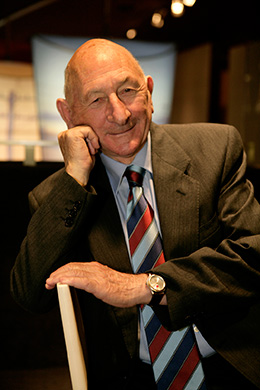22 September 2016
Tribute by the National Museum of Australia

The passing of Professor Emeritus DJ (John) Mulvaney AO CMG is a deeply sad occasion for the nation.
John was a remarkable Australian. Arguably the father of the disciplines of archaeology and Aboriginal history in Australia, he was a passionate public intellectual who through his teaching, research and activism, contributed much to the nation’s cultural life and how we understand our past.
At the National Museum we remember him as a major figure who advocated for the creation of our institution. An energetic and creative member of the Committee of Inquiry on Museums and National Collections 1974–75, he championed the establishment of a National Museum of Australia.
John was particularly passionate about the difference that a National Museum could make to the public understanding and appreciation of Australia’s Indigenous people and cultures. It was John who recommended the establishment of a separate Gallery of Aboriginal Australia.
Initially disappointed with the decision to locate the Museum on Acton Peninsula, after the Museum opened there in March 2001, John became a firm friend of then director Dawn Casey and was a strong, though not uncritical, supporter of the National Museum.
John was born in 1925 to an Irish immigrant father and an Australian mother and grew up in country Victoria. He greatly benefited from educational opportunities made available to him after returning to Melbourne from service in the Australian Air Force in World War Two. After gaining a degree in History at Melbourne University and later Prehistoric Archaeology at Cambridge University, John was appointed a lecturer at Melbourne University in 1954.
Although teaching ancient history, it was at this time that he embarked on archaeological fieldwork in Australia. John’s work revolutionised the way Australians understood Indigenous peoples’ history on this continent. Work that John and colleagues did in South Australia, Queensland the Northern Territory revealed the complexities of Aboriginal occupancy of Australia and an increasingly deep time frame, pioneering the use of radiocarbon dates to reach back to the last ice age.
In 1965 John, along with his wife Jean Campbell and their five children moved to the Australian National University (ANU) in Canberra. Later, in 1971, John took up the post of Professor of Archaeology in the School of General Studies at the ANU.
John was an inspiring teacher in Canberra and earlier in Melbourne, with many of his students going on to continue his achievements in Australian archaeology, heritage and history.
ANU was an exciting and productive place for John. In the late 1960s as part of a joint program with the ANU’s Research School of Pacific Studies, and researchers from Melbourne University, John was involved in the important discoveries of Aboriginal human remains at Lake Mungo, part of the Willandra Lakes complex in western New South Wales.
In his autobiography, John talked about how honoured he felt to be present for the discovery of ‘Mungo Lady’ who provided the earliest evidence in the world for cremation ritual. John later donated to the National Museum the suitcase used to move ancestral remains from Lake Mungo to the ANU.
In 1981, John had the further honour of introducing the successful nomination of the Willandra Lakes as a world heritage site at a World Heritage Committee meeting in Paris. John was justifiably proud of the part archaeology and his research efforts played in the acknowledgement and acclaim for the Lake Mungo National Park, with its evidence of the deep history of Aboriginal culture in Australia.
John’s career was built on strengthening the knowledge that archaeology continued to provide for documenting the great antiquity and continuity of Aboriginal civilisation in Australia.
After early retirement from his ANU professorship in 1985, he entered what one biographer has described as ‘a golden age of writing and publishing’. He wrote, co-authored or edited 16 books, including his autobiography, published in 2011. All of these contributions, written in his lucid style, remain a tribute to John’s passion for Australian history and to telling meaningful, research-based stories about our complex past.
In 2004 John’s first wife Jean died tragically, but John went on to find new happiness and commitment when he married Melbourne historian Elizabeth Morrison. John and Liz spent a happy ten years together, still involved in research and publications, but also treating themselves to tours of famous international gardens and creating their own beautiful garden at their Canberra home.
John will be much missed by the National Museum’s staff, Executive and Council and by the Museum’s Friends group, of which he was a long-term member. Our thoughts are with Liz and with John’s surviving children and their families.
We will remember John’s guidance and advice, his strength of personality, his infectious laughter and his passion for history and truth. Vale John Mulvaney, we are all the poorer for your passing.